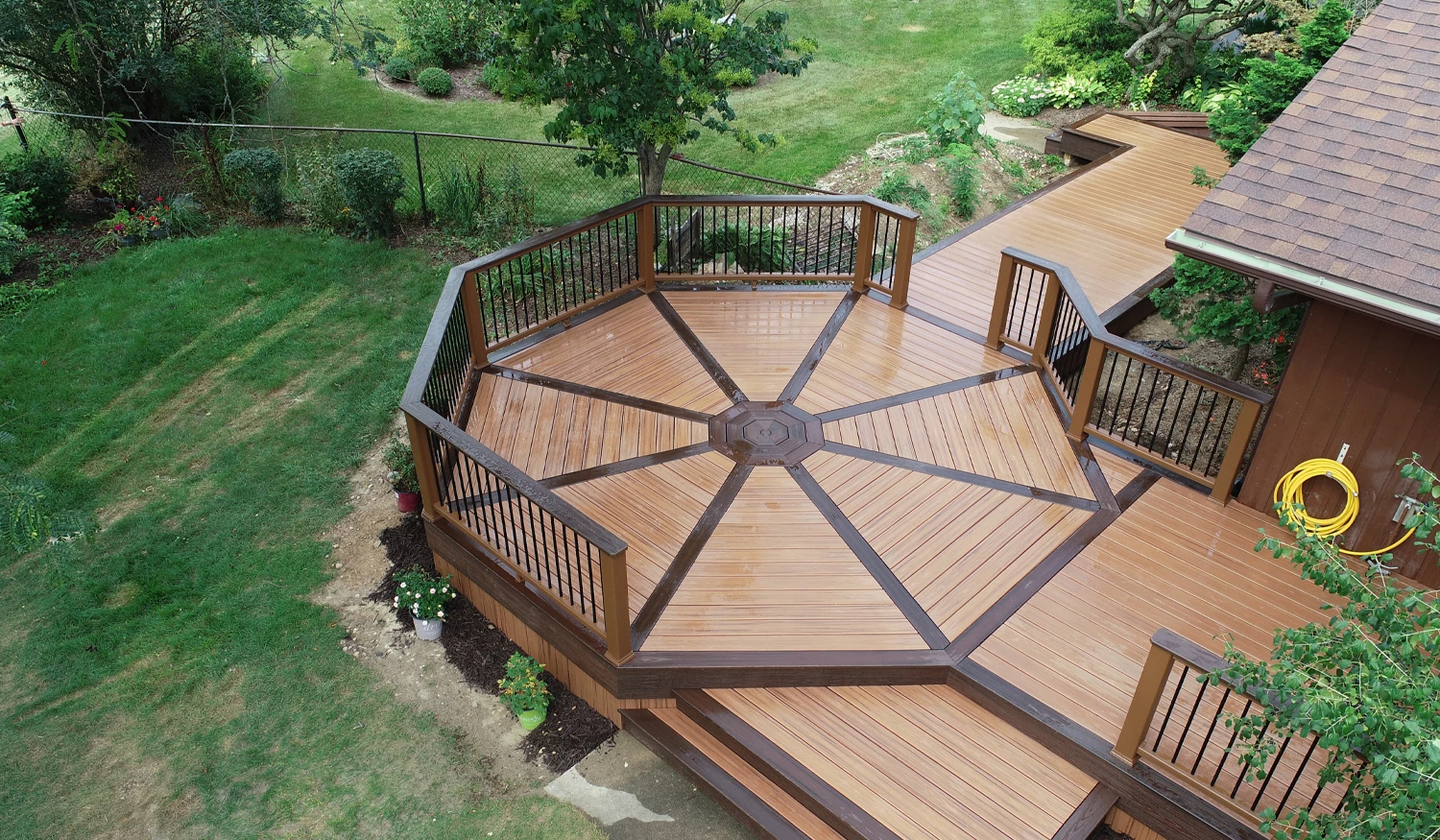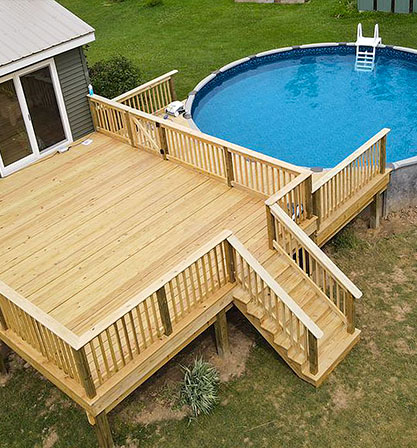How to Select the Right Products for Your Deck Installation Job
Selecting the appropriate products for your deck installation project can seem complicated. There are countless variables to think about, from sturdiness and upkeep to looks and environmental effect. The selection between traditional timber and composite materials, each with its own collection of advantages and disadvantages, can be specifically difficult. The trick is to balance your budget plan, layout preferences, and way of life requires to create a deck that will boost your outside space for years ahead.
Recognizing the Various Sorts Of Deck Materials
When starting a deck installation task, the choice of materials becomes an essential choice. Different options are offered, each with distinct attributes and aesthetic appeal. Standard timber, for example, provides a timeless, natural appearance and is normally much more cost-efficient. Nonetheless, it can warp in time and requires routine maintenance. Compound materials, on the various other hand, are a blend of wood and plastic, providing longevity and resistance to weather elements. They require much less upkeep contrasted to timber but are generally a lot more pricey. One more alternative is plastic, which is basically maintenance-free and resistant to bugs and rot, albeit much less natural-looking. By recognizing these differences, home owners can make a much more enlightened decision on the most suitable deck material for their details demands.
Evaluating the Resilience and Upkeep Needs of Deck Products
Examining the sturdiness and maintenance demands of deck materials is an important action in deck installment. Resilience includes the material's capacity to endure severe climate condition, wear and tear, and its long life. As an example, cedar and redwood are naturally resistant to rot and insects, making them resilient choices. On the other hand, pressure-treated timber, while long lasting, may call for even more upkeep due to its sensitivity to fracturing and warping.
Comprehending upkeep demands is similarly crucial. Some products need routine sealing or discoloring to keep their appearance and resist dampness damages, while others, like composite outdoor decking, require less upkeep. By assessing these aspects, one can choose one of the most appropriate outdoor decking material, making certain a balance between resilience, maintenance demands, and aesthetic charm.
Cost Analysis: Comparing Wood and Composite Decking
Although cost may initially look like a secondary issue, it is a substantial factor when comparing timber and composite decking. Timber, generally a much less pricey option, has a reduced ahead of time cost. However, over time, upkeep expenses can accumulate, possibly making timber a lot more costly over time. These maintenance expenses might include discoloration, securing, or replacing harmed boards. On the other hand, composite outdoor decking, while more expensive initially, needs less upkeep, potentially minimizing long-lasting expenses. It's vital to bear in mind that composite decking isn't resistant to wear and tear, and replacement prices can be high. Possible deck proprietors must consider their budget plan and determination to maintain their decks when determining in between timber and composite outdoor decking.
Aesthetic Appeals and Layout Adaptability of Decking Products
Natural timber decking gives a classic, classic appearance, while composite products provide a broad range of colors and appearances to fit diverse preferences and styles. Composite products, while much less adaptable in style, are still versatile enough for a lot of deck styles. These elements, for that reason, are critical factors in the option of decking product.
Ecological Impact of Decking Products
When selecting outdoor decking products, one must consider not just aesthetic appeals and resilience, however also the ecological influence. It is essential to assess the sustainability of materials and explore recycled outdoor decking options. Furthermore, recognizing the potential impact on local ecosystems will certainly ensure an extra ecologically liable selection.
Examining Product Sustainability
In the realm of deck building, evaluating product sustainability is an important step. This involves reviewing the environmental influence of each potential product, taking into consideration aspects such as the power required for its production, its carbon footprint, and its end-of-life disposal or recycling choices. For instance, timber is a renewable resource, but unsustainable logging techniques can result in logging. Composite decking materials usually incorporate wood and plastic, lowering the demand for brand-new hardwood however enhancing dependence on fossil fuels. Aluminum and investigate this site other metals might be a lot more resilient and recyclable, but their removal and processing can be energy-intensive. Therefore, the option of decking products should balance performance, visual appeals, cost, and sustainability to guarantee a responsible and long-lasting installment.
Recycled Decking Options

Compound outdoor decking is especially prominent due to its durability and convenience of upkeep. Recycled plastic outdoor decking, on the various other hand, is very resistant and needs marginal upkeep.

Effect On Local Ecological Communities
While the benefits of using recycled products for outdoor decking can not be overemphasized, it's just as crucial to consider the more comprehensive environmental implications of these selections. The removal, handling, and transport of products can greatly impact neighborhood ecological communities. Logging for timber outdoor decking adds to environment loss and climate change. Also the production of composite materials can launch dangerous discharges. Conversely, utilizing recycled or sustainably sourced materials can help alleviate these effects. Thinking about the life-span of products can minimize ecological effect; longer-lasting alternatives call for less frequent replacement, hence saving resources. Proper disposal of old outdoor decking is important to decreasing garbage dump waste. Essentially, an eco-conscious deck job demands cautious material option, lasting sourcing, and accountable disposal.
Making Your Final Decision: Tips for Selecting the most effective Deck Materials
As the article transitions right into the subtopic of "Making Your Final Decision: Tips for my link Selecting the most effective Deck Materials", it is crucial to comprehend the variety of deck materials available. Striking a balance between resilience and aesthetics is essential in this choice process. The adhering to discussion will guide visitors in making an enlightened selection based on these vital factors to consider.
Understanding Different Deck Products
The task of selecting the ideal products for your deck installation can appear discouraging due to the large variety of choices readily available. However, recognizing the different materials can streamline this process. Timber is a prominent choice, supplying a traditional aesthetic and cost. Kinds of wood used consist of pressure-treated lumber, cedar, and redwood. Compound materials, made from a blend of timber and plastic, are low-maintenance and resistant to rot and insects. Plastic or PVC decks are also much more long lasting and need much less maintenance than composite materials, but they can look much less natural. Last but not least, aluminum decks are solid, lightweight, and resistant to rot, however they are likewise the most pricey option. Each product has its very own benefits and downsides, making it essential to consider your certain needs prior to making a decision.
Toughness vs. Appearances Equilibrium
Balancing sturdiness with aesthetics can be a difficulty when choosing deck materials - deck installation. High-traffic areas may demand long lasting products like composite decking, which stands up to wear and tear yet might lack the natural elegance of timber. House owners require to strike a balance, considering both the deck's sensible needs and their visual preferences.
Verdict
To conclude, selecting the right materials for your deck installation task calls for careful consideration of variables such as toughness, maintenance, cost, looks, and ecological influence. Whether you select traditional timber or composite materials, your option ought to align with your spending plan, layout choices, and lifestyle. Eventually, the ideal outdoor decking material is one that boosts your outdoor space and offers satisfaction for many years to find.